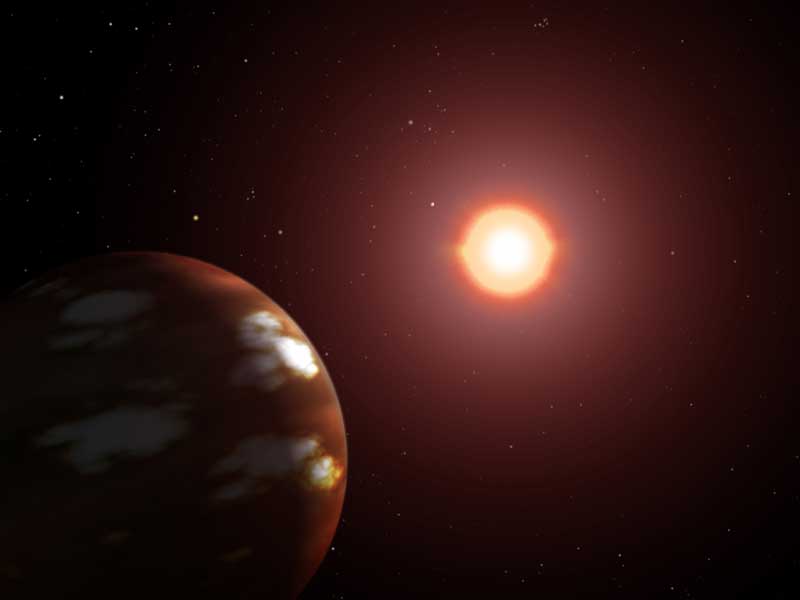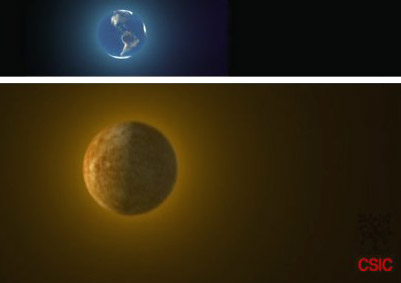|
Extra Solar Planets New Planets Discovered |
|
|
Neptune-sized extrasolar planet ..
NASA artist imagines the newly
discovered Neptune-sized extrasolar planet
circling the red dwarf star
Gliese 436. Here, the planet appears gaseous
like Jupiter, with a cloudy
atmosphere. However, astronomers don't know yet
if the newly discovered
smaller planets are gaseous like Jupiter, or
rocky like Earth and Mars
Other Systems Neptune, Jupiter and Earth are in our Solar System. The new small planets are in solar systems around the stars Gliese 436, 55 Cancri, and mu Arae. One of the newly-discovered planets is near three other previously discovered exoplanets orbiting the star 55 Cancri. Together, they form the first-ever-known four-planet system beyond our own system. The several discoveries were made by astronomers at the Carnegie Institute of Washington, University of California at Berkeley, University of Texas at Austin, University of Lisbon in Portugal, Marseille Astrophysics Laboratory in France, and University of Geneva in Switzerland. How were they found? The discoveries were made using a technique called radial velocity, in which a planet's gravitational pull is detected by the wobble it causes in the parent star. A star's movement, including any wobbling is calculated by measuring the Doppler effect on light arriving at Earth from the star. The wavelength of the star's light changes as it moves. That tells astronomers a lot about the star and objects near it, including mass, orbit and speed.
HOBBY-EBERLY TELESCOPE » LA SILLA TELESCOPE » |
|
Related Links:
NASA JPL Kepler |
|
| Gliese 436
GJ 436b,
A Neptune-size planet likely covered in hot—but solid—water has been discovered in a snug orbit around a nearby star, a team of astronomers announced today. While this planet is not fit for life, the finding suggests astronomers may soon detect habitable planets in similar alien solar systems, said Michaël Gillon of the University of Liège in Belgium. "We are just at the door of a very exciting era," he said in an email interview. The exotic water detected on the planet is known to form under extremely high pressure—conditions that can only be replicated on Earth in laboratories. The planet, called GJ 436 b, orbits a cool, red star at a distance of only 2.5 million miles (4 million kilometers). By contrast, Mercury, the innermost planet in our solar system, is 29 million miles (47 million kilometers) from the sun at its closest approach. The "hot ice world" is about 30 light-years from the sun. Four Times Earth's Size GJ 436 b was first detected in 2004 by the way it tugs on its parent star during orbit. This telltale sign allowed astronomers to determine it is at least 22 times as massive as Earth. Gillon and his colleagues re-examined the planet this year with several ground-based telescopes as the world passed in front of its host star. This "transit" dims the light from the star, indicating the planet's presence. Careful observations of the transit allowed the team to calculate the size of the planet —about four times the diameter of Earth—and also pinned its mass as 22 times that of Earth. "The planet is by far the nearest, smallest, and lightest transiting planet detected so far," Gillon said. He and his colleagues describe the new observations in an upcoming issue of the journal Astronomy & Astrophysics. Joseph Harrington is a planetary scientist at the University of Central Florida in Orlando and an expert on extrasolar planets. He was not part of the research team. He said transiting planets are "really important" because they allow scientists to increase understanding of planets elsewhere in the universe as well as our own solar system. "Whenever you learn about familiar things in exotic environments, it really opens up your thinking and understanding of familiar things in familiar environments," he said. Exotic Ice Knowing the size and mass of the planet allowed the team to infer it is mainly composed of water, based on models developed by Jonathan Fortney at NASA Ames Research Center in Moffett Field, California. If the planet contained mostly hydrogen and helium, like Jupiter, it would be much larger. And if it were made of rock and iron, it would be much smaller, like Earth and Mars, according to the model. Since the planet orbits so close to its star, astronomers expect a minimum surface temperature of 475 degrees Fahrenheit (245 degrees Celsius). And, the astronomers said, pressures within the planet are intense, allowing for the exotic "hot ice." As it does in a swimming pool, pressure on planets increases with depth. Since the planet is thought to be primarily a water world, the pressure acts on the water. "Water has more than a dozen states, only one of which is familiar ice," Frédéric Pont, a study co-author from the Geneva Observatory in Switzerland, said in a statement. "Under very high pressure, water turns into other solid states denser than both ice and liquid water, just as carbon transforms into diamond under extreme pressures," he added. Inside the planet, the researchers said the exotic ice is heated to several hundred degrees. The planet is likely enveloped by hydrogen or helium, like Neptune or Uranus, but could be surrounded by water vapor, the team added. (See an interactive map of our solar system.) Harrington, in Orlando, said the team's calculations and characterization of GJ 436 b appear accurate. "This planet should have a substantial component of its interior, maybe even most of it, being made of this solid form of water," he said. Ocean Planets The ability to detect GJ 436 b with ground-based telescopes suggests it only a matter of time until astronomers detect Earthlike planets with this method, Gillon said. (Read related story: "First Habitable Earthlike Planet Found, Experts Say" [April 24, 2007].) He and his colleagues are re-examining nearby planets like GJ 436 b that were first detected by the way they tug on their parent stars, a technique called radial velocity. "As more and more smaller rocky planets are detected by radial velocity, the probability that one of them is transiting its star increases," Gillon said. "So we will get for sure in the near future the transits of a terrestrial planet." The team is focused on small, cool faint stars like GJ 436 b's host star. These so-called red dwarfs make up 75 percent of the stars in the Milky Way. "If by chance we detect a transiting terrestrial planet orbiting in the habitable zone of a tiny nearby red dwarf, the near-to-come James Webb Space Telescope could even be able to detect traces of life in its atmosphere," he said. (Read related story: "Hubble
Successor
Under Way, Will See Even Farther" [June 8,
2004].)
© 1996-2008 National Geographic
Society. All rights
reserved.
|
|
|
Gliese 436 c Mysterious "Super Earth" Is Smallest Known Exoplanet? ..
The so-called super-Earth is believed to orbit a red dwarf star about 30 light-years away in the constellation Leo. If confirmed, the planet will be among the smallest known and the first found by looking for its effect on a neighboring world. Image courtesy CSIC GJ 436c
The eccentric orbit of a Neptune-like planet could be evidence that the distant gas giant has a smaller, rocky neighbor, astronomers say. If confirmed, the new terrestrial world will be one of the least massive exoplanets known to orbit a sunlike star and only the second known warm "super Earth." Although they are five or more times as massive as our world, super-Earths are thought to be rocky rather than gaseous—which makes them strong candidates for harboring life. Ignasi Ribas of the Spanish National Research Council in Bellaterra and colleagues describe the possible new world in the April 6 issue of The Astrophysical Journal. Ribas and colleagues say the planet, dubbed GJ 436c, orbits a red dwarf star about 30 light-years away in the constellation Leo. According to the study team, GJ 436c would also be the first exoplanet revealed by its affect on the orbit of a planetary neighbor. "Because of this," Ribas said, "the study opens a new path that should lead to the discovery of even smaller planets in the near future, with the goal of eventually finding worlds more and more similar to the Earth." Four-Year-Long Day Ribas and colleagues predicted GJ 436c after noticing that GJ 436b, the known Neptune-like exoplanet, passed in front of its host star in 2007. Observations in 2004 had not revealed such a transit. Computer models of the system therefore suggested that another world was affecting the gas giant's orbit. The models predict that the new planet is a rocky type with a radius some 50 percent larger than Earth's. Temperatures on the planet range between 260 and 800 degrees Fahrenheit (127 and 427 degrees Celsius), the team calculated. "But it could locally be as low as 170 degrees Fahrenheit (77 degrees Celsius) at the poles, depending on the type of atmosphere," team member Giovanna Tinetti of University College London said in a press release. GJ 436c appears to makes an orbit around its host star in only 5.2 Earth days, compared to Earth's roughly 365-day orbit. And unlike Earth's 24-hour rotation, the planet makes a full revolution on its spin axis in 4.2 Earth days. This means that a full day on the new planet would take four planetary years, or roughly 22 Earth days. Stephane Udry, of the Observatory of Geneva in Switzerland, announced the discovery of the potentially habitable super-Earth Gl 581c last year. He said the new planet, if confirmed, would be another piece to an exciting puzzle. "I am completely convinced that habitable rocky worlds around stars similar to the sun will be discovered in a close future," he said. "We are living in an exciting time." But he's not convinced yet that the latest super-Earth is real, because of conflicts in previous data. "For me the planet's existence, although possible, is still academic." Wobble and Bend Most of the 280-plus known exoplanets have been found using a technique called Doppler wobble, which detects planets' gravitational tugs on their parent stars. The wobble method most easily detects gas giants similar to the mass of Jupiter, although some with masses below ten times that of Earth's have also been found. Several super-Earths also have been revealed by Doppler wobble. Jean-Philippe Beaulieu, a visiting astrophysicist at University College London, called GJ 436c the "hot twin" of the frozen super-Earth OGLE-2005-BLG-390Lb that he and colleagues discovered two years ago. That similarly sized world was found using gravitational microlensing, a method that looks for objects between Earth and a star by detecting how light from the star bends. He says the new find provides an important new technique for detecting smaller terrestrial exoplanets. "It is important to build up a large zoo of extrasolar planets, to understand their properties," Beaulieu said. "Soon one of them will be [found] in the habitable zone"—the region around a star where liquid water is able to exist. But the authors agree that more confirmation is needed to prove the existence of GJ 436c. "The story of the planets orbiting this red dwarf [GJ 436] is not yet completely written," Beaulieu said. "More fun should be expected in the coming months." © 1996-2008 National Geographic Society. All rights reserved. http://news.nationalgeographic.com/news/2008/04/080411-smallest-planet.html |
|
| FAIR USE NOTICE: This page contains copyrighted material the use of which has not been specifically authorized by the copyright owner. Pegasus Research Consortium distributes this material without profit to those who have expressed a prior interest in receiving the included information for research and educational purposes. We believe this constitutes a fair use of any such copyrighted material as provided for in 17 U.S.C § 107. If you wish to use copyrighted material from this site for purposes of your own that go beyond fair use, you must obtain permission from the copyright owner. | |
|
|


